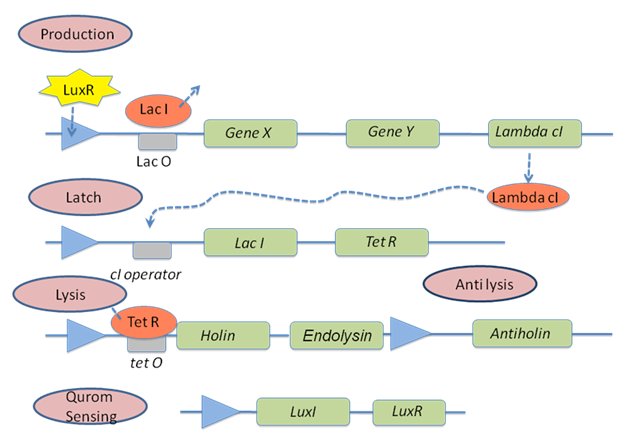Team:Aberdeen Scotland/internal/deterministic
From 2009.igem.org
| Line 105: | Line 105: | ||
</tr> | </tr> | ||
| + | <tr> | ||
| + | <td><img src="https://static.igem.org/mediawiki/2009/0/09/Theta.gif"><sub>HSL</sub></td> | ||
| + | <td></td> | ||
| + | <td>Rate of diffusion of HSL in/out of the cell</td> | ||
| + | </tr> | ||
| + | <tr> | ||
| + | <td><img src="https://static.igem.org/mediawiki/2009/0/09/Theta.gif"><sub>IPTG</sub></td> | ||
| + | <td></td> | ||
| + | <td>Rate of diffusion of IPTG in/out of the cell</td> | ||
| + | </tr> | ||
| - | + | <tr> | |
| + | <td><img src="https://static.igem.org/mediawiki/2009/0/09/Theta.gif"><sub>IPTG</sub></td> | ||
| + | <td></td> | ||
| + | <td>Rate of diffusion of IPTG in/out of the cell</td> | ||
| + | </tr> | ||
</table> | </table> | ||
| Line 118: | Line 132: | ||
[[Image:Mu.gif]] | [[Image:Mu.gif]] | ||
[[Image:Theta.gif]] | [[Image:Theta.gif]] | ||
| + | [[Image:K.gif]] | ||
{{:Team:Aberdeen_Scotland/break}} | {{:Team:Aberdeen_Scotland/break}} | ||
== References == | == References == | ||
Revision as of 12:49, 10 August 2009
University of Aberdeen - Pico Plumber
Contents |
Deterministic Model
Introduction
Our circuit is constructed on 5 different plasmids, with the aim of using no more than 2 different plasmids for the final construction. From each plasmid, mRNA is transcribed, followed by ribosome translation of these mRNA strings into proteins. For the different promoters the maximal production strength varies depending on the ribosome affinity for polymerase.
Firstly we split the different constructs according to the different mRNA they produced. We have 5 different constructs, each of which was assigned arbitrary names. The first construct, which produced mRNA for glue production, (or in the current case GFP, which we are using as proof of concept), and Lambda cI was termed “mRNA_production”. The second construct which produces LacI and TetR is named “mRNA_latch”. Holin and Endolysin are transcribed from the mRNA produced by the “mRNA_lysis” construct. The name we gave for the mRNA with the code for Antiholin is “mRNA_antilysis”. Finally, the quorum sensing proteins, LuxI and LuxR are transcribed by the last mRNA, which was termed “mRNA_qs”.
Figure 1: Circuit of our Pico Plumber
As it is visible in figure 1, three repressors and one activator are built into the circuit. On the production plasmid, AND- gate behaviour, activated by the presence of LuxR-HSL and IPTG, triggers the production of the glue and cI. However, because the lux box is a transcriptional activator, the input of LuxR-HSL only increases the maximal transcription rate of the promoter. Thus, we have to assume a leakiness of the promoter on the production plasmid in the presence of IPTG [1]. Once cI is produced, it represses mRNA_latch transcription, causing glue production to stay on even if there is no IPTG present. This is the latch behaviour we require. Another consequence of cI production will be repression of TetR. This leads to, after a natural degradation of TetR, to the transcription of mRNA_lysis and hence production of Holin and Endolysin. The cell will then lyse when there are 1000 more Holin proteins then Antiholin proteins present in the cell. This number is an assumption, which had to be made due to a lack of information available. SOURCE
The two proteins, LuxI and LuxR are constitutively produced. LuxI together with SAM, which is constantly present in the cell, forms, via an enzymatic process, HSL. HSL can freely diffuse in and outside the cell. If the concentration of HSL outside a cell is high enough, the HSL concentration inside the cell reaches a high enough level such that it can combine with LuxR and form a complex LuxR-HSL. In the future referred to as P, which activates the lux box on mRNA_production [2] [3] [4]. The other trigger, IPTG is released from the hole in the pipe. Since we wouldn’t have LacY in the cell we just need to consider IPTG diffusion through the cell membrane [5][6]. Beside the natural degradation of the proteins, we also took into account the dilution due to cell growth. All these information were summarized in the following differential equations:
Equations for mRNA transcription
Parameter description
| Parameter | Value | Description | Reference |
 X X |
Degradation of X | ||
 Y Y |
Degradation of Y | ||
 λ-CI λ-CI |
Degradation of lambda CI | ||
 X X |
Degradation of X | ||
 LacI LacI |
Degradation of LacI | ||
 TetR TetR |
Degradation of TetR | ||
 Holin Holin |
Degradation of Holin | ||
 Endolysin Endolysin |
Degradation of Endolysin | ||
 Antiholin Antiholin |
Degradation of Antiholin | ||
 Protein Protein |
Translation rate of Protein | ||
 |
Rate of production of HSL from LuxI | ||
 HSL HSL |
Rate of diffusion of HSL in/out of the cell | ||
 IPTG IPTG |
Rate of diffusion of IPTG in/out of the cell | ||
 IPTG IPTG |
Rate of diffusion of IPTG in/out of the cell |
References
[1] Alon, Uri. An Introduction to Systems Biology Design Principles of Biological Circiuts. London: Chapman & Hall/CRC, 2007
[2] Ward, J.P., J.R. King and A.J. Koerber. “Mathematical modelling of quorum sensing in bacteria.” IMA Journal of Mathematics Applied in Medicine and Biology 2001: 18, 263-292
[3] James, Sally et al. “Luminescence Control in the Marine Bacterium Vibro fischeri: An Analysis of the Dynamics of lux Regulation.” JMB 2000: 296, 1127-1137
[4] Goryachev, A.B., D.J. Toh and T. Lee. “System analysis of a quorum sensing network: Design constraints imposed by the functional requirements, network topology and kinetic constant.” BioSystems 2006: 83, 178-187
[5] Chung, J. D. and Greogry Stephanopoulos. “On the Physiological Multiplicity and Population Heterogeneity of Biological Systems.” Chemical Engineering Science 1996: 51, 1509-1521
[6] Nichols, J.C. and K.S. Matthews. “Combinatorial Mutations of lac Repressor.” The Journal of Biological Chemistry 1997: 272, 18550 -18557
 "
"


